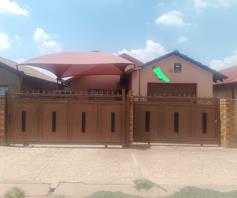Passive heating and cooling are the new buzzwords, especially with escalating Eskom tariffs and an increasing green consciousness that's making us think twice about our energy footprints and consumption on every level.

The views might be fantastic but don't be seduced into enormous picture windows; the amount of heat gain in summer is phenomenal. Go outside for the view.
There are many ways to passively cool your home in summer at little or no cost, and the only energy you'll be consuming is your own.
1. Shutters are fabulous - may they never go out of fashion.
There is nothing more restful on a blazing day than the filtered shade of classic louvred shutters.
When you open the windows and close the shutters the air is cooled by resistance as it flows through those narrow spaces between the slats.
2. Sliding external louvres may be a bit of a luxury to install but they'll deliver a payback far in excess of the initial outlay.
Award-winning Australian architect, Glen Murcutt's homes in the blazing outback never use airconditioning. They are all passively cooled and one of his primary defences is the aluminium shutter.

If you have a loft, open the doors at both ends to release the hot air.
3. If you have a loft, open the doors at both ends to release the hot air. The house interior will immediately cool by several degrees. Some Victorian homes (and clever new houses) have decorative vents in the pitched wall ends to release hot air.
Loft doors that open are even better. And if you have none of these, install a ‘whirly-bird’ extractor to draw hot air out of the ceiling and loft spaces.
4. Ceiling insulation is essential.
If it's a new build, consider installing the brilliant and affordable Isoboard (styrofoam) ceilings available in traditional tongue-and-groove, or sheer sheeting.
These ceilings have outstanding insulation properties, eliminate the need for additional insulation, are labour-saving and less expensive than other ceiling materials.

Do not wear synthetic clothing, but do wear a hat and sunscreen and eat lots of watermelon.
But existing homes, too, can gain great benefits from installing thermal sheeting throughout the roof spaces.
5. The views might be fantastic but don't be seduced into enormous picture windows; the amount of heat gain in summer is phenomenal. Go outside for the view.
6.The trend towards sheer curtaining or window blinds with no curtains at all is costing you more than you think.
Heavy lined curtains go a long way to cooling a room in summer and keeping it warm in winter. And by cutting the glare, the ambience is at once more restful, and feels much cooler.
7. Do remember the old-fashioned advice to open doors and windows early in the morning to let overnight heat out and fresh morning air in.
By around mid-morning when it starts hotting up, close all the doors, windows, curtains and blinds on the north and west side of the house until late afternoon when you reverse the procedure.
8. Don't be tempted by conventional air conditioners or heat pumps which convert to coolers in summer. The bills will be crippling.
Your best investment ever may be an evaporative cooling system - they are healthy, effective and robust, with minimal maintenance and running costs.
Remember however, that they are fully effective only in low-humidity areas. Most evaporative coolers are roof-mounted with ducts into as many rooms as you like.
Mobile floor units, although not as effective, are also available.
9. Don't forget about the good old colonial ceiling fan - they also keep the mosquitoes away at night and you won't need stuffy mosquito nets and toxic sprays.
10. If it's a new build, install opening fanlights above the external doors, and a row of high-level windows to release hot air as it rises in the room; this is particularly relevant in the kitchen and any west-facing rooms.
11.Verandas may look cool but they can be heat traps.
Remembering the obvious, that hot air rises, plan your veranda roof leaving a 15cm gap between the roof sheeting and the vertical wall, then run the upper roof sheeting over and beyond the gap.
The venting effect will be fantastic. The veranda will be cooler and so will the adjoining rooms.
12. They've done it for centuries in the Mediterranean countries and they are perfect for our climate.
When designing a new home, do make a courtyard. It can be a haven of coolness and shade, and increases the size of the house with an extra outdoor ‘room’.
If it has a fold-up or roll-away shade cover, so much the better when winter comes and you want to let the sunshine in.
Or create a courtyard style space in the drying yard which is largely wasted space, or perhaps that neglected area outside the back door; and install an outdoor shower there for a quick al fresco splashdown on hot summer nights.
13. Trickling water immediately makes everything seem cooler and installing a fountain or water feature in the patio is restful and has real benefits, cooling hot air by evaporation.
14. Patio misters (micro-jets from the hardware or garden store powered by a small pump) are a boon for people and plants.
15. If you have gravelled areas around your house and garden, give them a good hose-down in the morning and evening; this will cool the surrounding area by evaporation – at least for a while.
16. Keeping direct sun off the windows reduces heat gain dramatically; you can do this quickly with awnings and screens.
While it will take a bit longer, strategic planting can make a great contribution to keeping the house cool. Fast-growing ornamental vines and many of the flowering creepers will quickly cast shade on the hottest windows in the west and north.
17. For those who live on smallholdings or farms, consider using your concrete reservoir as a swimming pool, or build a small dam that can do double duty as a plunge pool and a container for your borehole irrigation water.
It can be constructed entirely above ground, or partially sunk, leaving low surrounding walls for seating and planters. Because the water is regularly exchanged (irrigating and re-filling), there's no need for chlorine as well.
18. Thatched roofs may offer the best year-round insulation but they come at a price; a quick cool-down is a coat of white roof paint and if it's a tin roof, a coat of thick whitewash is particularly appropriate (quick and cheap too) because by the time winter comes it will have worn off and the roof will be ready to reabsorb heat for winter.
19. New granulated roof paints are emulating ancient wisdom; in hot Arab countries, roofs would be finished with small stones or coral chips embedded in the plaster material.
The multi-faceted surfaces increase cooling effects exponentially.
Take advantage of the soaring temperatures and turn the geyser thermostat down. Switch it off for two hours during the hottest part of the day.
20. Try cooking with a solar oven just for fun. The slow food movement would approve, even if you just do your rice and pulses in it.
21.Do not wear synthetic clothing, but do wear a hat and sunscreen and eat lots of watermelon.
It's a wonder-fruit that replaces fluids and electrolytes and has tons of additional nutritional benefits as well. - Elaine Hurford, Country Estates







